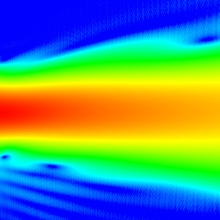For the ITER nuclear fusion experiment currently under construction, a heating system is developed, which uses millimeter waves at 170 GHz at a power of at least 24 MW to heat the plasma to fusion-relevant temperatures. At such power levels, only components significantly larger than the wavelength (1.76 mm) can be used. Such oversized systems are very sensitive with respect to geometry disturbances due to manufacturing tolerances, thermal expansion and other effects. The resulting field distortions (= spurious modes) lead to higher losses in the transmission lines and the antennas as well as a reduced heating efficiency in the plasma. The exact field distribution at the end of the transmission line is, however, inherently unpredictable.
In order to enable a risk assessment, a special Monte Carlo method was developed at IGVP, which generates a large number (> 10,000) of field distributions and statistically evaluates the resulting behavior of the system.
As the simulation of the entire system for a specific field distribution can take many hours, this is only carried out for a small number (10-15) of relevant eigenmodes. The complex field distributions of these fundamental solutions are then saved and the analysis done on the linear combinations of these fundamental solutions. This makes this type of analysis, which would otherwise require many years of computing time, possible in the first place.


